The Knowledge & Learning Commons – a library’s evolution driving cultural change at the United Nations in Geneva
Viviane Brunne, Programme Manager, bibliothèque des Nations Unies à Genève
Sigrun Habermann, Manager de la bibliothèque des Nations Unies à Genève
The Knowledge & Learning Commons – a library’s evolution driving cultural change at the United Nations in Geneva
1. Introduction
A “commons” is a mechanism to pool and jointly use resources. In economic and political theory, the concept is famously linked to a metaphor by Garrett Hardin, with herdsmen sharing a common pasture. In Hardin’s example, what sounds like a reasonable approach goes terribly wrong, because – in the absence of any regulation or governance mechanism, the herdsmen put in as many cattle as possible to graze to maximize their own benefit. In the end, overgrazing meant ruin for all (cf. Hess/Ostrom 2006: 10-11).
Libraries, in a way, have adopted the approach of pooling resources – books, journals, newspapers – and make them available as a common good. Often funded publicly and available to users for free or against a small fee, they provide just the type of management structure that helps to maximize the use of the pooled resources for as many people as possible and over longer periods of time.
In the context of libraries, it appears that the benefits of information, knowledge and learning resources can actually be multiplied when shared, rather than depleted as in the example of the pasture (Bollier 2006: 28, 34). It may come as no surprise that libraries have evolved naturally around the concept of the commons, taking it further to encompass new areas of activity. This article will explore the evolution of libraries as commons and illustrate it with the case study of the UN Library&Archives Geneva (L&A).
To better understand the context, we will first outline the particularities of this specialized Library which is embedded in the institutional context of the United Nations and bears the heritage of the League of Nations, in many ways its predecessor. This will help to flag the differences to the libraries in university campuses and public libraries that have experimented with various types of commons over the past three decades. Taking their examples as a point of departure, we will show the unique particularities of the Knowledge & Learning Commons at the UN in Geneva (1) which is not only a vehicle for the L&A to evolve but one to drive innovation and cultural change across the organization at large. We will follow the path of the UN Geneva Commons from its early experimental stages into a more structured programme and explain how human-centred design approaches were applied to develop it, in co-creation with its users. We will show how constant assessment has been the driver of the programme which was put to a sudden test by the new situation caused by Covid-19 from March 2020 onwards. Following its own innovation principles, the UN Geneva Commons adjusted through experimentation and is ready to move to the next level in 2021. We will conclude with a reflection on the current challenges and opportunities and anticipate some developments of the near future.
2. A brief look at who we are - The United Nations Library & Archives Geneva
The beginnings of the UN L&A Geneva were with the League of Nations, the first global intergovernmental organization for peace. With its founding in 1919, the League started a library service. A major milestone for the Library was the donation of a dedicated building by John D. Rockefeller Jr. Finished in 1936, it represents an entire wing of the Palais des Nations. The Library was then one of the most modern in Europe: with 9 public halls, 10 floors of stacks, and ample office space it was ready to serve as a centre of international research and an instrument of international understanding (Sevensma 1927).
World War II and the demise of the League put a temporary hold on further developments, and when the League’s assets were transferred to the United Nations in 1946, the Library collections and the historical Archives became part of the European Office of the organization, later named the United Nations Office at Geneva (UNOG). UNOG today is a diplomatic centre with near universal representation of UN Member States, bringing them together with individuals and organizations working on peace, rights and well-being for all. About 12’000 meetings are held every year and the Library’s resources and services reflect the multitude of their topics, including key collections in the areas of international law, human rights, diplomacy and international relations, disarmament, sustainable development, humanitarian affairs, and the environment. The Library today is uniquely placed to inform and enable work on multilateralism.
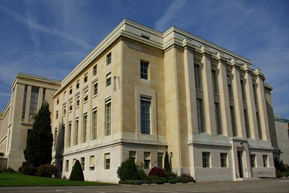
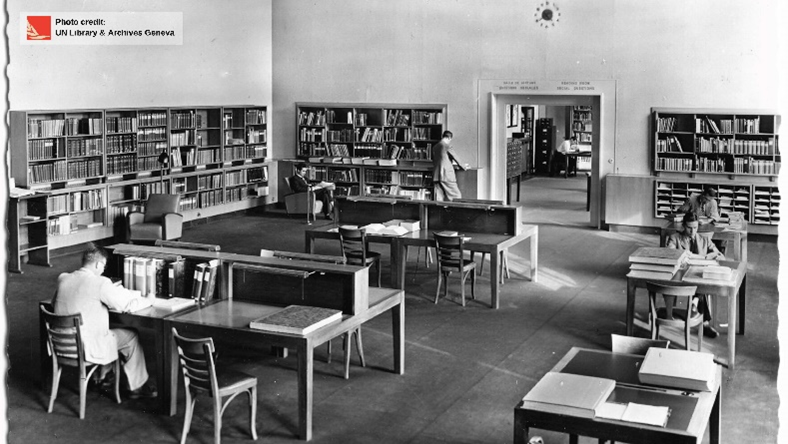
Over time, UNOG conferred further responsibilities to the Library, including managing the United Nations and League of Nations Archives and managing UNOG records. It is the curator of the League of Nations Museum and of more than 2'000 art works at the Palais des Nations, and it manages UNOG’s rich cultural activities programme. These significant functional additions allowed the Library to reinforce its role, both as research centre and as an instrument of international understanding.
With its broadening scope of activity, the L&A staff have acquired skills and experience in cultural diplomacy, event management and outreach. These competencies are put to use, for example by coordinating the activities around the celebrations of “100 Years of Multilateralism in Geneva” in 2019/2020, and supporting global agendas, such as the 2030 Agenda for Sustainable Development. They also enabled L&A staff to reply to a call to action on innovation launched by UN Secretary-General António Guterres, to cater for the rapidly changing nature of the UN systems. In response to this call and based on research in library trends and the future of working and learning, the UN L&A proposed a novel cross-service initiative – “the Knowledge and Learning Commons”.
3. The development of the concept of commons in other libraries
The idea of creating new organizational forms and label them as “commons” as an evolution of libraries first appeared with the emergence of the internet in the mid-1990s, often on university campuses, responding to changing user needs by making library services and technological resources available in one place. McMullen (2007: 2) summarizes the approach: “Whether they call themselves an Information Commons, Learning Commons, Knowledge Commons or simply Library, they are envisioning new spaces and new partnerships to create environments that can support the integrated service needs of the digital generation. ‘As a new model of service delivery, it is not about technology per se, but how an organization reshapes itself around people using technology in pursuit of learning’ (Beagle 2006: p. xv)”.
Information commons have often been described as the first stage in this new development. Pursuing a new model of information service delivery, they contribute to information literacy, building the competence of users to access information effectively and to be able to judge its value. While providing computer workstations and collaborative learning spaces, overall, information commons remain library-centric (Bailey/Gunter Tierney 2008: 1-3; cf. also Wolfe/Naylor/Drueke 2010: 109).
As Heitsch/Holley (2011) explain, “The Learning Commons is an evolution of the Information Commons in which the basic tenets of the information are enhanced and expanded upon in order to create an environment more centreed around the creation of knowledge and self-directed learning.” The core activity of a learning commons is no longer merely the mastery of information, “but the collaborative learning by which students turn information into knowledge and sometimes into wisdom” (Wolfe/Naylor/Drueke 2010: 109).
Learning commons are normally more strategically aligned with an institution-wide vision and mission. They become an active partner in implementing the broader educational and research agendas of institutions, often collaborating with the learning centres but also bringing in other partners such as administrators, faculty and students (Sullivan 2010: 132; Bailey/Gunter Tierney 2008: 1-3, 7-8). Learning commons move away from a library-centric approach to more human-centred design. They involve the users to develop the learning environments they need, and they use a multitude of creative formats - cultural events, exhibits, concerts, discussion forums etc. - to promote the social inclusion of a learning community (Sullivan 2010: 139-143). As “a place for experimenting, playing, making, doing, thinking, collaborating, and growing”, the learning commons is a place the users treasure as “their space” (Loertscher/Koechlin 2014: E3-E4).
Inspired by the literature about library commons elsewhere, the L&A commissioned an external researcher to study the feasibility of the model at UNOG. Analyzing scientific literature, the outcomes of user and staff surveys at UNOG and of interviews with the commons staff at Harvard University, the University of Nebraska, (both US), and the London School of Economics (UK), she concluded that the concept supported the Organization’s mission and vision of promoting multilateralism, sustainable development and intercultural dialogue through education, information, and communication. The study suggested that especially if created as a partnership between the L&A and UNOG’s Centre for Learning and Multilingualism (CLM)(2) part of UNOG’s Human Resources Management Service, the Commons would enhance a “culture of shared knowledge, community learning and innovation" while also enhancing the role of the individual entities’ core activities.
4. What is the concept of the Commons at UNOG?
Encouraged by the conclusions of the study, L&A engaged with the Centre for Learning and Multilingualism in a cooperative approach to developing the Commons. To achieve a unified knowledge on learning environment for the common client base - UN staff and diplomats - the Library’s events hall and specialized reading rooms were identified as ideal spaces for both, quiet and collaborative activities. Added value would be achieved through the pooling of competencies and technological resources, and through a more diversified approach to building and sharing knowledge.
New natural partners became available through “#NewWork”, an innovation initiative to promote a collaborative environment, favouring innovation and risk-taking as well as flexible working. The initiative had emerged, partly in response to the Secretary-General’s call for innovation, partly as a reaction to demands from staff for changes in the workplace culture. When the Commons was presented to UNOG’s senior management, the group recognized that it was a matter of “common sense” for the organization. The Commons provided the space where this new vision could be shared and where collaboration across services could happen in practice.
Outside UNOG’s internal setting, the UNOG operates within a dynamic ecosystem, with more than 40 international organizations, more than 400 NGOs and academic institutions specializing in international relations. This means that there is a constant supply of resource persons with the potential for peer learning. Research suggests that informal learning is likely to amount to 90% of staff learning, with only 10% of knowledge creation happening through formal training (3). Complementing the approach of informal learning in the immediate work environment, the Commons also lends itself as a space to bring the wealth of knowledge available in the larger international community in Geneva to a wider audience.
In addition, the Commons is well-placed to provide a space where the traditional silos that form around technical organizations could be broken down. As Niestroy/Meulemann (2016) point out, building transversal awareness has become a new requirement at a time when the UN system, along with its Member States, have commited to implement the ambitious 2030 Agenda for Sustainable Development. With this new all-encompassing and transformational policy framework, a new need to “focus on facilitating dialogue, interaction and learning” came to the fore (Niestroy/Meuleman 2016). The idea of the Commons was to facilitate the creation of knowledge and learning communities around topics of common interest across organizations and user groups.
From its early days, the Commons was meant:
- to create synergies between L&A and CLM to build knowledge communities among UN staff, Permanent Missions and interns in Geneva
- serve as a space for informal learning, knowledge exchange and collaboration
- provide a space to experiment and innovate, thereby promoting a cultural change within the organization.
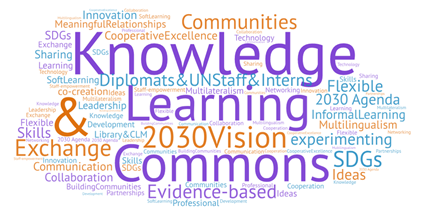
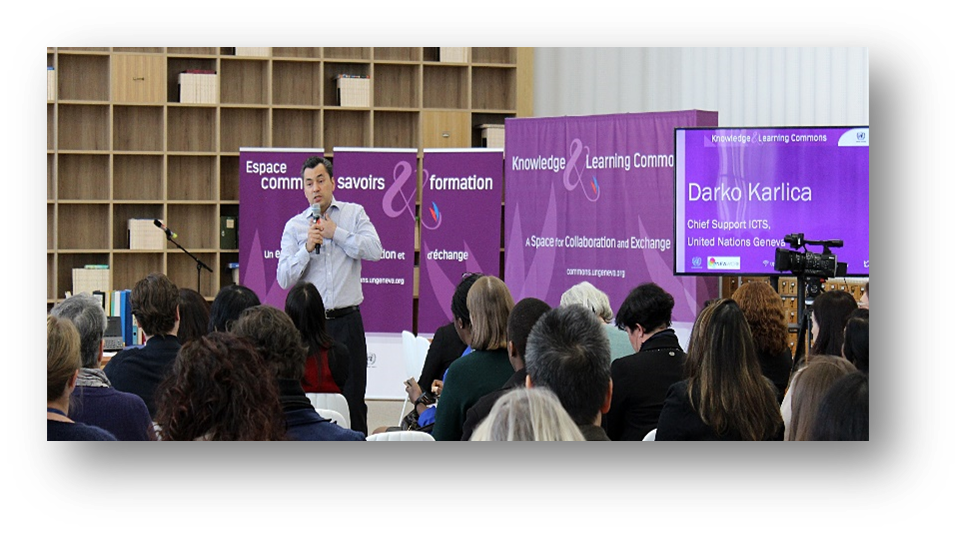
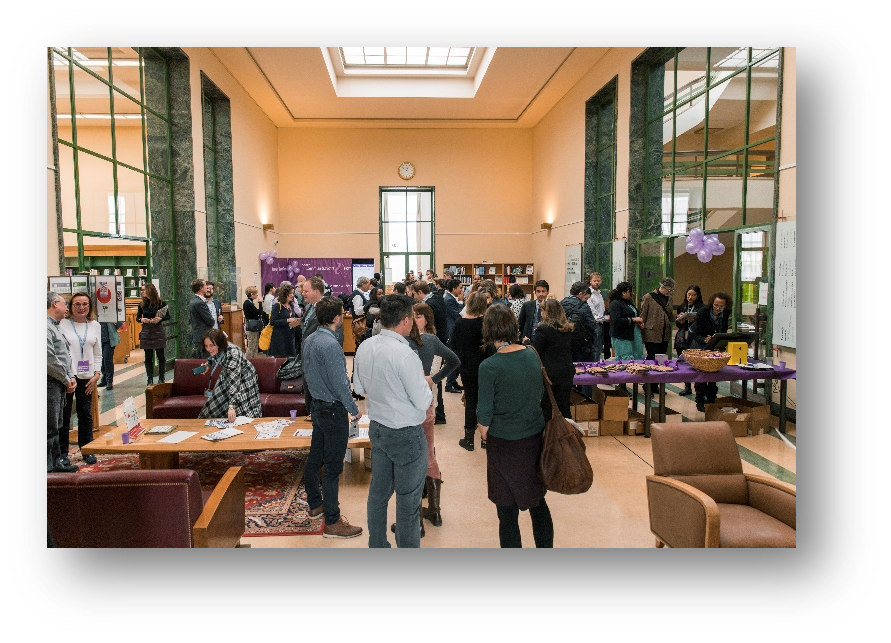
5. From the experimental phase to a structured programme
To drive and accompany the development of the Commons, an Engine Group was established consisting of a cross-section of staff from both, the UN L&A and CLM. In addition, management structures at the Commons were consciously kept lean to promote innovation and set an example in light of the hierarchical organizational culture. Senior management played a minimal role in setting general directions or pointing to some key opportunities. Anyone, including a diversity of partners and our own interns, was invited to bring in ideas for events and decisions about best topics were taken collectively at the Commons team level.
To get started, planned L&A and CLM events in the pipeline were reviewed as to their Commons compatibility and some were redesigned using formats that favoured innovation and interactivity. In April 2018, the first Knowledge and Learning Commons event took place called: “Face Value – how to overcome stereotypes in our professional and personal lives”. Other events followed, on libraries and knowledge networks, digital diplomacy and design thinking. Overall, some 20 activities took place during the first year of the Commons’ operation.
To give the programme a clearer profile, a management decision was taken to carry out a Knowledge and Learning needs assessment. Based on the evidence of this assessment about the real needs of the target group, the focus of the Commons’ activities should be further refined. The assessment also served to gain potential partners who might be willing to become co-creators of the Commons’ programme. At the same time, senior management were involved, enquiring about their vision for the organization as an indicator of new capabilities for the staff.
The assessment was implemented between October 2018 and January 2019, in time to drive the development of the catalogue of activities for the pilot year 2019. This assessment combined qualitative and quantitative methods and included 134 participants in interviews and focus group discussions, of which 22 were diplomats (including several Permanent Representatives and Deputy-Permanent Representatives) and 7 interns. Several internal debriefs and discussions about lessons learnt at the Commons also fed into the overall analysis for this assessment.
Based on the information collected, five priority streams were identified for 2019 and the purple hand (purple being the colour of the Commons, a mix of the red of the Library and the blue of CLM) became the visual identifier for the Commons. The streams were to focus the activities and to facilitate the evolution of knowledge communities around themes of common interest. Given the prominence of gender among potential users, it was included as a cross-cutting theme, symbolically marked in the palm of the hand.
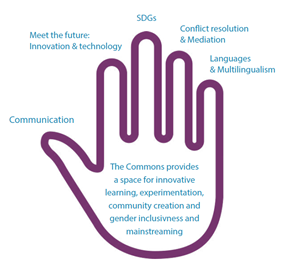
To remain open to emerging issues and unexpected opportunities, a conscious decision was taken to keep 20% of the capacity for good ideas.
While offering learning events seemed an obvious first step, in the medium-term it was also envisaged to provide other products and services. Conceptualizing the Commons as a “space” was also a defining element. The spacious and newly renovated Library Events Room lent itself to creative use as it could be set up flexibly (unlike many of the typical conference rooms around the Palais des Nations). By using the spaces of the Library creatively, we hoped to contribute to building the brand and inspire users to think out of the box, simply by venturing outside their usual environments.
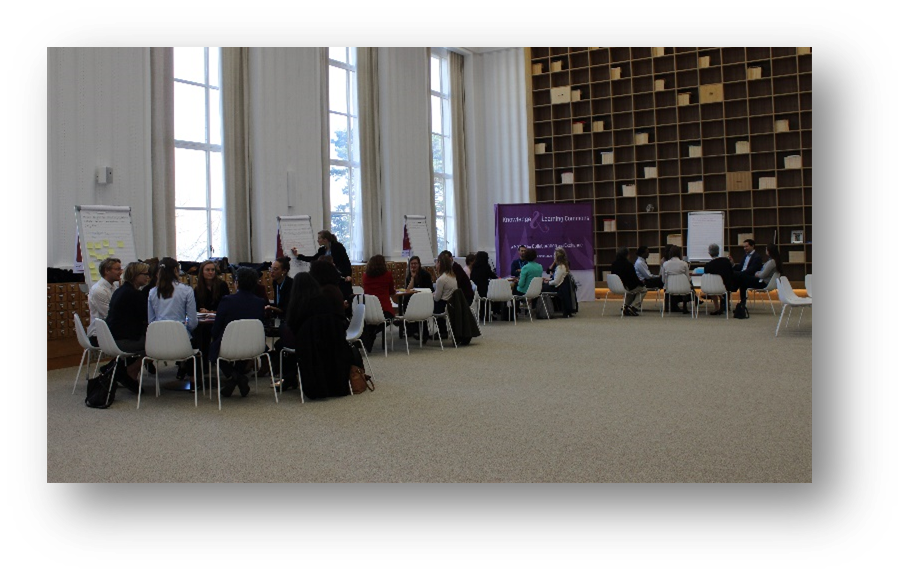
6. The Pilot year: 2019
The pilot year was launched with a housewarming party inviting our three target groups to experience the 2019 programme with short taster sessions. Some 250 participants participated in the event which resulted in a boost in subscriptions to our newsletter. By the end of the year we had held 47 events with a cumulative total of 2.870 participants. Among the highlights was a session with the trainers of previous TEDx events held at the Palais des Nations who coached volunteers of all ranks in effective public speaking, much as they would the speakers for a real TEDx event. In a Dragon’s Den, UN staff was asked to submit their innovative ideas to improve the UN’s operations. Five selected teams were invited to promote their projects and two finalists, one selected by the audience and one by the “dragons” (senior staff and an external innovation champion), subsequently received mentoring and innovation time off to work to advance their projects. One of the winners, Conecta, a skills data base connecting staff to opportunities, was recently launched. Ready to scale, the project pitched again at a global Dragon’s Den organized by the UN at headquarters and was once more selected as one of the winners. The #MondayMotivation series inspired participants concerning IT applications, software or other tools that facilitate remote working or collaboration, for example with MS Teams. To promote an innovative culture, creative event formats or proposed activities were encouraged that directly promote creativity, for example related to creative writing or collaborative music playing.
As Sullivan (2010: 143) points out, human-centred design approaches, as used for the UN Geneva Knowledge & Learning Commons, require ongoing assessment. Launching into the implementation of the pilot year, it was obvious that evidence was required on how the initial planning decisions were developed. Therefore a comprehensive monitoring and evaluation strategy was developed, combining OECD evaluation criteria with the Kirkpatrick model commonly used to evaluate learning activities (4). Within a small working group, a number of high-level analytical questions were developed, which were then further broken down into questions pertaining to three levels: the project level, the priorities for the year and the organization of individual events. Six information sources were identified as relevant to respond to our guiding questions:
- Quantitative indicators
- A short user feedback survey (online)
- In-depth client interviews (in-person, at events)
- A survey among non-users (online and in-person)
- Interviews with senior management (in-person)
- An internal debrief among the core team (in-person).
Firstly, with regard to the project-level, the surveys showed that users attached high value to informal learning and knowledge exchange. Users and non-users alike supported the goals of the Commons – to provide a space to innovate and experiment, thereby promoting a cultural change towards more innovation. With the main goals so strongly confirmed, by the end of 2019 it was accepted that there was a proof of concept.
Figure 1 : The non-users' perspective on the goals of the Commons
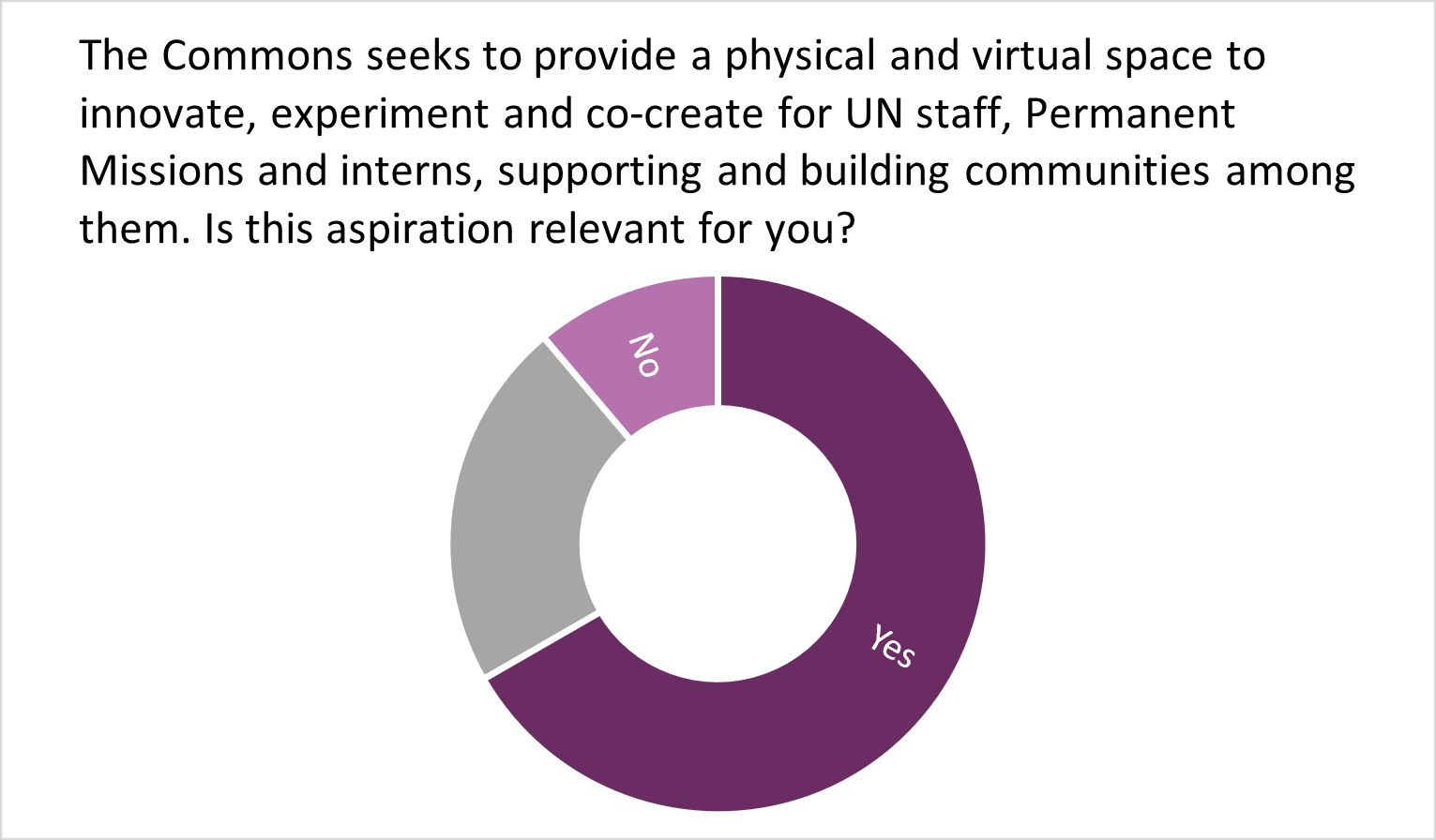
Secondly, looking at our priority streams, the programme’s focus on innovation was reflected in the high number of events in the “Innovation & Technology” stream - almost a third of the 2019 programme. The feedback gathered during the year from both, users and non-users, confirmed an overwhelming interest in Innovation & Technology and Communication. Both streams were therefore maintained for the following year. Events labelled as “Other”, representing our “20% for good ideas”, accounted for another third of events, with about half of them covering issues related to wellbeing. Given the interest in the topic and the availability of excellent partners, it was decided to include Well@work as a new separate stream into our 2020 catalogue, thereby broadening the former Conflict resolution & mediation stream of 2019.
In response to a growing interest in efforts to “green” the Palais des Nations and to promote more sustainable behaviours at the individual and organizational level, the emphasis on the Sustainable Development Goals (SDGs) evolved into a Sustainability stream in 2020. This was a conscious decision for a niche that was outside the mainstream SDG events where the Commons had no comparative advantage.
Only two events had taken place under the Languages & Multilingualism stream, however, multilingualism - at least for the UN Secretariat languages English and French - was mainstreamed across many events. Conscious that multilingualism was best promoted by actually creating a multilingual environment, rather than by simply organizing events promoting it, this stream was discontinued in 2020.
Figure 2 : Events by steam in 2019
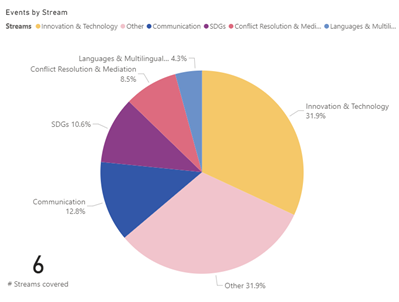
The Partnerships topic had already been relatively prominent during the initial needs assessment. In the 2019 non-user survey, it ranked third. It was decided to include a corresponding stream into the 2020 catalogue, given its potential to bring new audiences.
Figure 3 : Priority topics for non-users
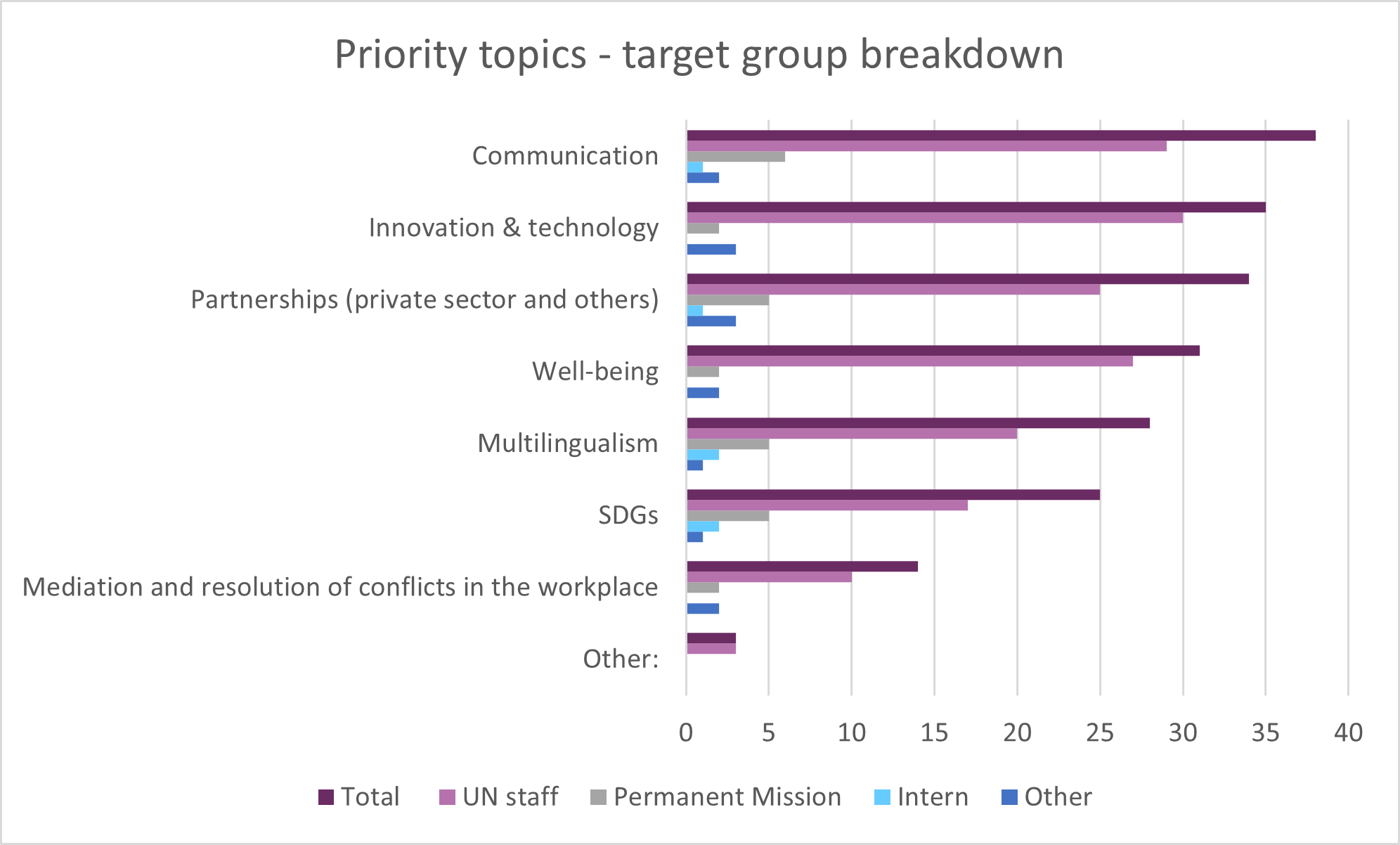
Organizing events that were of interest for Permanent Missions was already a priority in 2019. Communication efforts to make the Commons better known among diplomats had yielded some results – about a fourth of new subscriptions to the newsletter came from Permanent Mission staff. In 2020 it was decided to go one step further and introduce a separate Diplomacy stream that could provide a space uniquely dedicated to diplomats and their needs.
In terms of gender balance, the Commons had a good record in 2019: 55% of participants in 2019 were female and 48 of the speakers were female and 53 were male. To keep this issue in focus and also become more conscious of promoting other aspects such as accessibility, we introduced the broader headline of inclusion and diversity as a cross-cutting principle.
Thirdly, through the different feedback mechanisms, critical insight was received which helped to improve the way events were organized. For example, participants were asked if they had acquired knowledge or information from the events which they could apply in their work or elsewhere, to which 69% of survey participants responded in the affirmative. In the internal debrief difficulties were openly discussed including issues faced when working on learning events with partners who were not professional trainers. For 2020 a more standardized template was developrd for the preliminary discussions with partners that would obligate the articulation of learning objectives for every event. These objectives would then also be communicated with all event announcements, as a constant reminder to all contributors.
Figure 4 : Learning outcomes and applicability
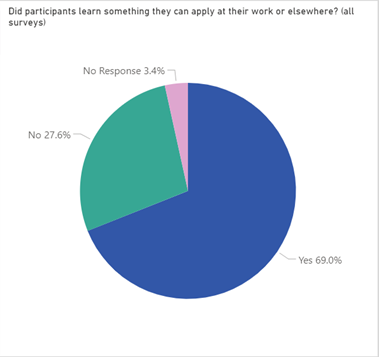
Since an important aspiration of the Commons was to offer innovative and interactive sessions, event participants were also asked about these factors. Users generally appreciated the use of the software Slido or other software to facilitate the discussion. Based on the overall feedback, however, it was decided that these were areas that required more investment. In 2019, it was noted with surprise that many of the partners who came to the Commons as a space to experiment with innovation, had insisted on using standard formats such as panel discussions. Knowing that they would not be the most effective formats for adult learning, it was decided to ban the use of panel discussions in 2020, and to commit to continuously explore innovative and interactive formats that we would be suggested to our partners. To facilitate longer-lasting interactions among participants, it was also planned to make a more concerted effort to cultivate “communities of practice” around certain core issues of the Commons where participants could exchange about their experiences in applying some of their new learning insights in practice.
Figure 5 : Innovation and interativity in event formats
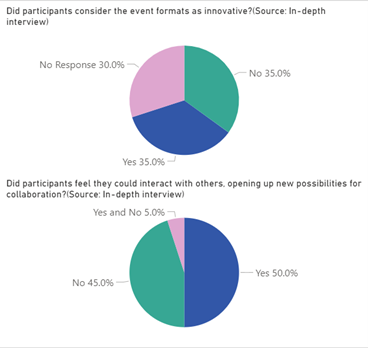
Overall, by using a scientifically sound and highly analytical approach to monitoring and evaluating the pilot year at the Commons, the programme set a new precedent, inspiring evidence-based service development also in other parts of the L&A.

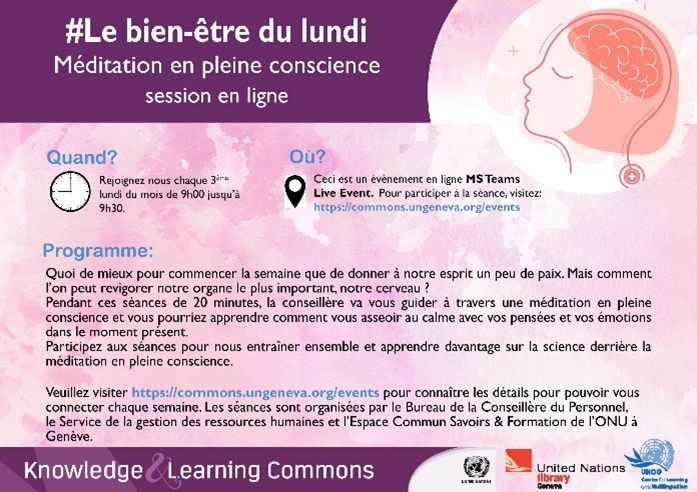
7. The COVID-year: 2020
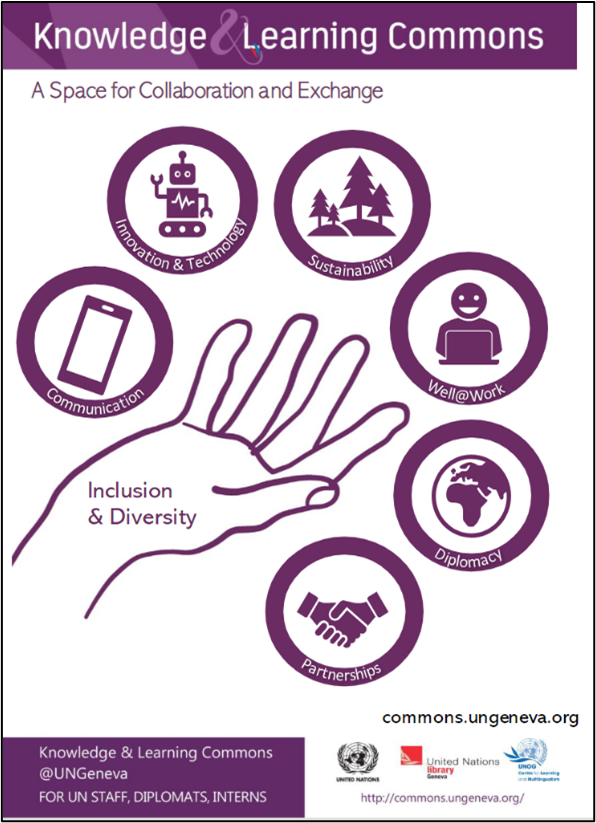
With the launch of new approaches, by 2020, it would be one year since the housewarming in early February. At that point partners were contacted and the new priority streams were presented, brainstorming with them about activities for the year.
By the end of 2019 the initiative became a victim of its own success. Four events per month seemed like a healthy maximum of what could be managed, however, by early 2020 there were as many as eight pre-bookings per month.
Confronted with lockdown from mid-March, all events in the pipeline had to be put on hold. The upside: it freed up time to bring a project to the fore that had been pursued on the sidelines - the Conference Primers platform (5). The idea went back to feedback received from Permanent Missions, especially the smaller ones, who were struggling to follow all relevant conferences to be able to brief their capitals about main outcomes. The Conference Primers would be a service to them, as much as to all our target groups, curating the best summary information about key conferences of interest in international Geneva. The platform covers all key areas of work in Geneva, including human rights, innovation and technology, economics and trade, the sustainable development goals, etc. It contains official conference pages alongside summaries prepared by NGOs, think tanks or news media. The approach to the Conference Primers was, once more, very much related to that of a “Commons”, as experts were engaged to assist in identifying and vetting the best resource pages on specific topics. While Commons staff regularly invest time into updating the platform, the idea is that the Primers may evolve into a “Wikipedia”-type of page, with users continuously adding their best resources. As Bollier points out (2006: 36), the evolution of “participatory media” is just another expression of the commons paradigm.
In the meantime, the event production team got ready to offer the first events online. In response to an obvious need, a series of talks with the staff counselors were organized, under our Well@work stream. Topics included “Keeping a healthy mind” and “Coping with fear and anxiety during COVID-19” or “Preparing emotionally for the return to the workplace”. In addition, regular mindfulness sessions in English and French were scheduled.
As the team became more used to managing the available online events platforms, other topics were gradually brought back in. In September a new series called HiSTORIES was launched, with a first session on “The League of Nations Essentials: Shedding New Light on the 1st Global Multilateral Organization”. This initiative responded to feedback suggesting the Commons should capitalize more on the strengths and resources available at the L&A. Another series, produced by the Commons under the headline #UNGenevaReads, went back to an initiative by staff of the L&A. As in a traditional book club, colleagues gathered to jointly read a book about climate change, pointing to concrete corrective actions any individual could take.
An online event was the organized, broadcast from the Palais des Nations, discussing the book with the authors and responding to questions from the global readership. A small group of colleagues is currently selecting the books for future discussions.
Figure 7 : The #UNGenavaReads announcement
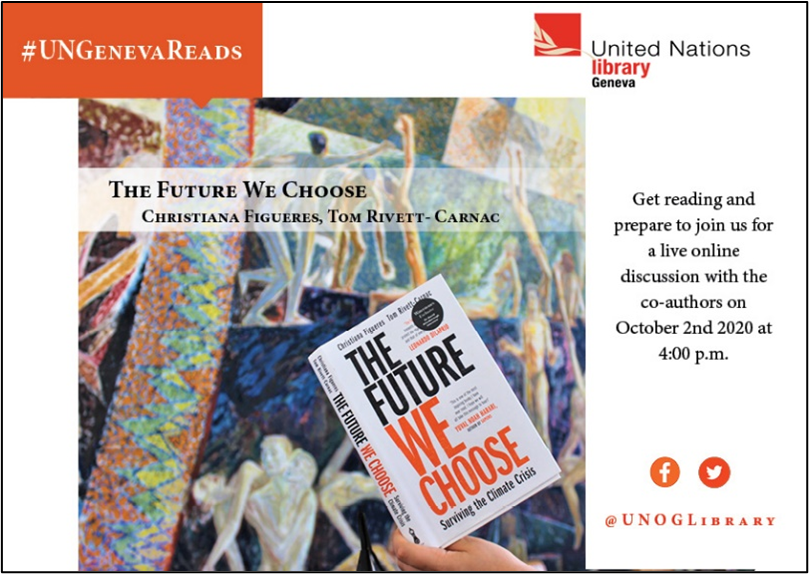
By end of October, the Commons had hosted 52 events with 3685 participants – more than in the whole of 2019. From mid-March onward, they were all held online. The team has built a unique experience in organizing virtual events, making the Commons a go-to place for such formats. Remote working had been a topic at the Commons before. The crisis provided the necessary impetus to make remote participation in events part of the “new normal”, thereby responding to the needs expressed by our users already in our initial assessment.
8. Conclusion and what’s next?
Two years into its existence, the Knowledge & Learning Commons of the UN Geneva has proven its worth. Many close observers have judged the pilot year to be a “resounding success”. An important factor was support from senior managers and strong allies within and outside the organization. Over time, partnerships have evolved and become more complex, suggesting that a more strategic approach to partnerships management might soon become necessary. In the near future, working with UNOG’s IT service might become even more important. Even before Covid-19, it was recognized that the learning commons required “a fundamentally new degree of collaboration between librarians and information technologists, who bring different professional training and cultures together in newly designed spaces that support [...] learning” (Bennet 2007). The #MondayMotivation series testified to that. Evolving with the technological advances will now more than ever be a key factor to maintain the Commons as a vibrant innovation space.
While fully embracing the technological advances, they have also made community-building - at the core of the initial Commons idea – all the more difficult. Virtual events meant a greater difficulty to create a sense of community among users being virtually connected. #UNGenevaReads is one attempt to build back community. Increased interactivity in virtual sessions is another, but the challenge remains.
As the monitoring and evaluation results confirm, Commons activities are contributing to a cultural change towards more innovation within the organization in many practical ways. The ongoing challenge remains - to strike a good balance between letting partners and users own the Commons while also guiding them to the adoption of more innovative formats. The hope is that with the increase of the Commons community, “Learning for Us” becomes an enabling tool, letting innovation come to full circle.
What is crucial is the willingness and capacity of the Commons team to continually learn, not only in the IT area, but also in terms of innovation in substance and form of delivery. As Sullivan (2010: 144) highlights: “the single unifying element of the many manifestations of the learning commons is change”. Commons staff members have to remain agile and always be a few steps ahead of the users. Delivering constant innovation becomes a crucial staff skill in itself. It is the ability to identify emerging trends and quickly explore their potential. As McMullen (2007: 20) confirms for other learning commons: “Individual staff members […] are constantly in a learning mode and continually evolving to meet user demands. […] Staff continually update their job skills, enjoy learning and don’t feel threatened by the changeable nature of their jobs”. In this manner, the Commons innately realizes the cultural change the UN is looking for.
While the growing demand of the Commons translates into an increasing need for human and financial resources, pressures to reduce budgets greatly affect L&A and CLM. Programme sustainability can only be achieved when these needs are addressed, and alternative ways of funding have to be explored.
It’s clear that the Knowledge & Learning Commons at the UN in Geneva has established itself as a vehicle that has allowed the UN Library & Archives to profit from its multifaceted activities – ranging from library, records and archives services, to outreach, artworks management and cultural programming – and to evolve into an institution that can face the information and communication challenges of the 21st century. Within the bureaucracy of the United Nations, the programme reaches sustainability through agility and innovation, interaction and inclusion, thereby turning staff and users into drivers for cultural change. Looking back at the humble beginnings of the Commons, the staff are proud to be able to contribute to the renewal of the Organization through this innovative approach, providing concrete results for knowledge sharing.
Notes
(1)https://libraryresources.unog.ch/conferenceprimers
(2)CLM provides learning opportunities, mostly to UN staff, in some cases also to Permanent Mission staff, in particular in the six official UN languages, in management and communication. CLM also promotes an increasing number of online learning offerings, produced at headquarters in New York or accessible through online learning platforms such as LinkedIn learning.
(3)What is the 70:20:10 Model?, https://www.growthengineering.co.uk/70-20-10-model/ (last accessed 6 November 2020).
(4)For the OECD evaluation criteria, cf. www.oecd.org/dac/evaluation/daccriteriaforevaluatingdevelopmentassistance.htm; for the Kirkpatrick model, cf. for example here: https://www.mindtools.com/pages/article/kirkpatrick.htm; some of the pitfalls of the model mentioned in the article are alleviated by the complementary use of the broader approach of the DAC criteria.
Bibliography
Bailey, D. Russel/Gunter Tierney, Barbara (2008), Transforming Library Services Through Information Commons, Chicago.: American Library Association.
Bennett, Scott (2008), The Information or the Learning Commons: Which Will We Have?, in: The Journal of Academic Librarianship, vol. 34, no. 3, pp. 183-185, https://libraryspaceplanning.com/wp-content/uploads/2015/09/The-Learning-or-Information-Commons-Which-Will-We-have.pdf (last accessed 25 October 2020).
Blake, Sheila (2015), The Challenges of Creating a Learning Commons, University of Central Missouri, Warrensburg, Missouri, http://docplayer.net/163627834-The-challenges-of-creating-a-learning-commons-sheila-l-blake.html, (last accessed 25 October 2020).
Bollier, David (2006), “The Growth of the Commons Paradigm”, in: Understanding Knowledge as Commons: From Theory to Practice, Hess, Charlotte/Ostrom, Elinor (editors) Cambridge, MA: MIT Press, pp. 27-40.
Brooks Kirkland, Anita/Koechlin, Carol (2015), Leading Learning: Standards of Practice for School Library Learning Commons in Canada, https://llsop.canadianschoollibraries.ca/, (last accessed 25 October 2020).
Canadian Library Association (2014), Standards of Practice for School Library Learning Commons in Canada, http://apsds.org/wp-content/uploads/Standards-of-Practice-for-SchoolLibrary-Learning-Commons-in-Canada-2014.pdf (last accessed 25 October 2020).
Clement House rotunda project: An Evaluation of Clement House Informal Learning Spaces (2016/2017) London School of Economics, http://eprints.lse.ac.uk/82259/1/Roger_The%20Clement%20House%20rotunda%20projectn_author_2017.pdf (last accessed 25 October 2020).
Fuller, Kate (2009), Learning Commons @ UConn Assessment Report: Use and Satisfaction of the Learning Commons, http://learningcommons.uconn.edu/about/UConn_Learning_Commons_Report.pdf (last accessed 25 October 2020).
Heitsch, Elizabeth K./Holley, Robert P. (2011), “The information and learning commons: Some reflections”, in: Review of Academic Librarianship, Vol 17 No. 1, pp. 64-77.
Hess, Charlotte/Ostrom, Elinor (2006), “Introduction: An Overview of the Knowledge Commons”, in: Understanding Knowledge as Commons: From Theory to Practice, Charlotte Hess and Elinor Ostrom (editors), MIT Press.
Holland, Beth (2015), 21st-Century Libraries: The Learning Commons; in: Edutopia, https://www.edutopia.org/blog/21st-century-libraries-learning-commons-beth-holland (last accessed 25 October 2020).
Lippincott, Joan K. Chapter (2006), Linking the Information Commons to Learning. In: Learning Spaces, Diana G. Oblinger, ed., Educause, https://www.educause.edu/research-and-publications/books/learning-spaces/chapter-7-linking-information-commons-learning (last accessed 25 October 2020).
Loertscher, David/Koechlin, Carol (2014), Climbing to Excellence: defining characteristics of successful learning commons, https://www.davidloertscherlibrary.org/wp-content/uploads/2020/07/2014-Climbing-to-Excellence-Defining-Characteristics-of-Successful-Learning-Commons-1.pdf (last accessed 25 October 2020).
McKay, Richard (2015), Building a Learning Commons: Necessary Conditions for Success. Community & Junior College Libraries, volume 20, 2014 – issue 3-4, Taylor & Francis online
http://www.tandfonline.com/doi/abs/10.1080/02763915.2015.1056705?journalCode=wjcl20 (last accessed 25 October 2020).
McMullen, Susan (2007),The Learning Commons Model: Determining Best Practices for Design, Implementation, and Service, Sabbatical Study, Roger Williams University
Available at: http://faculty.rwu.edu/smcmullen/index.html (last accessed 25 October 2020).
Niestroy, Ingeborg/Meuleman, Louis (2016), Teaching Silos to Dance: A Condition to Implement the SDGs, http://sdg.iisd.org/commentary/guest-articles/teaching-silos-to-dance-a-condition-to-implement-the-sdgs/ (last accessed 22 October 2020).
Letter from A. Sevensma, Director of the League of Nations Library to R. Fosdick, Rockefeller Foundation, New York, NY. (1927), LON archives 16/29433/3749
Sullivan, Rebecca M. (2010), Common Knowledge: Learning Spaces in Academic Libraries, in: Academic Libraries, College & Undergraduate Libraries, Volume 17, pp. 130-148.
Thibou, Shevell (2016), The Learning Commons. Western Washington University Libraries
http://cedar.wwu.edu/cgi/viewcontent.cgi?article=1005&context=research_process (last accessed 25 October 2020).
The University of Iowa Libraries – Learning Commons
Available at: https://www.lib.uiowa.edu/commons/ (last accessed 25 October 2020).
University of Nebraska Adele Hall Learning Commons, https://libraries.unl.edu/learning-commons and https://news.unl.edu/newsrooms/today/article/learning-commons-named-for-alumna-adele-coryell-hall/ (last accessed 25 October 2020).
Vasisht, Prateek, The Public Library of 2027, Snipette
https://medium.com/snipette/the-public-library-of-2027-50eabd05b8c2 (last accessed 25 October 2020).
Wolfe, Judith A./Naylor, Ted/Drueke, Jeanetta (2010), “The Role of Academic Reference Librarian in the Learning Commons”, in: Reference and User Services Quarterly, Volume 50, Issue 2, pp. 108-113.